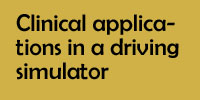Car driving simulators are particularly known for their use in driver training, police training, and also for their application in DUI simulation and demonstrating the effects of driver distraction. However, a driving simulator can be also be succesfully applied in a number of clinical applications, especially fear of driving, evaluation of fitness to drive and rehabilitation in a clinic.
Treatment of fear of driving
For clinical psychologist who treat various anxieties and phobias and use exposure therapy to treat their clients, a simulator can be an instrument in the treatment of fear of driving or driving phobia. Exposure therapy involves the exposure of the patient to the feared object or context without any danger, in order to overcome their anxiety. Giving exposure therapy to people with fear of driving in a real car in traffic is difficult in practice: the real risk of accidents is high and always involves a licenced driver instructor as well as a therapist which makes the therapy sessions expensive and difficult to arrange. Also, the environment is in real car in the real word is impossible to control, which is definitely not what a therapist wants. Exposure therapy in a driving simulator to treat fear of driving gives the therapist a controlled virtual environment in which the client is exposed to the anxiety inducing situations without any danger. Virtual reality is used more often to treat phobias.
Evaluation of fitness to drive
Fitness to drive for older drivers and drivers with neurological disorders, after CVA or sleep disorders is typically done by general practitioners using paper and pencil tests, blood samples and eye measurements. However, a simulator can make the fitness to drive test more ecologically valid: it resembles the driving tasks and testing can be done in a structured environment with the same test for all clients. While a simulator may someties be less suitable for the assessment of driving behaviour in older people, because of the increased risk of simulator or cyber sickness in this population, the incidence of simulator sickness can be reduced substantially, when a number of precautions are being taken in the design of the tests. Simulator tests can be a valuable addition to the set of diagnostic instruments to evaluate fitness to drive.
A special branch of clinical applications is the use in a test battery of neuropsychological tests. In a research simulator setup, clinical tests can be developed, for example to evaluate if patients with sleeping disorders are at risk of falling asleep while driving.
Driver rehabilitation and occupational therapy
A driving simulator program can offer a number of practice to people in occupational therapy for the purpose of driver rehabilitation. Especially, turning at intersections, reacting to unexpected events and negotiating fourway intersections and roundabouts can be trained in this group. The goal of driver rehabilitation is to aid individuals with disabilities or age-related impairments maintain independent driving and transportation. This maybe done through the use of specialized mobility equipment and training.

